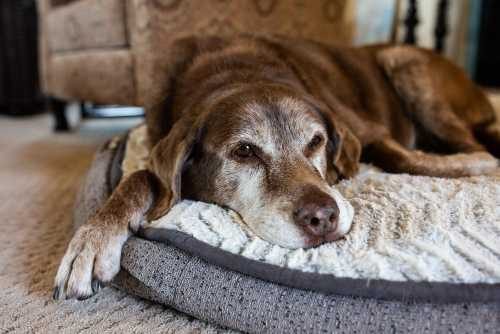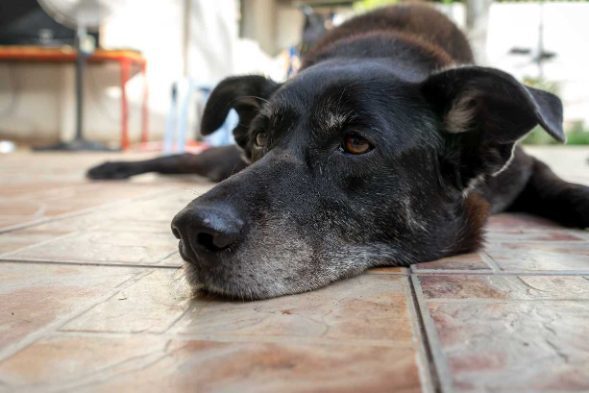
Some senior dogs experience discomfort from arthritis, hip dysplasia, or other age-related issues. These medical conditions can happen to dogs of all ages, but they are prevalent in older animals. Despite their lack of mobility and decreased appetite, these aged pets can still be mischievous and act like little children -- when they act cranky, it's frustrating for their owners. At the same time, because they are so active, senior dogs can be a lot of fun around the house.
Veterinarians and pet owners can often identify most conditions that cause joint pain in senior dogs by looking at their X-rays. If the dog's joints appear to have degenerated -- if the bones seem weak or jutting out slightly from the rest of it -- then arthritis could be a possible cause. Chronic pain from arthritis can often lead to behavioural changes, making your dog more nervous and anxious around you. Dental disease may also play a role; if a dog's mouth is dry or sensitive to touch, then dental issues may be causing discomfort.
If your dog feels pain in his joints and is not improving with medical treatment, then these 12 natural ways to relieve joint pain may help. They will also make your dog feel more relaxed and happier, benefiting you both.

1. Ease the pressure on the joint areas with a water bottle filled with ice cubes. Always use cold water to relieve pain from arthritis. Fill an empty plastic bowl or jug with cold water and place it in the freezer overnight so that it stays cool enough to relieve sore joints throughout the day. Place a small number of ice cubes in your dog's water bowl before giving him a drink, and make sure he takes his time drinking the water. If he drinks too fast, he may swallow too much air, which can cause discomfort in his stomach or digestive system.
2. Apply a warm wrap or heating pad to the common area. Both methods are great for reducing pain from arthritis as your dog moves around. For example, if your small dog suffers from hip dysplasia, apply a heating pad to any part of the joint that is bothering him. Some dogs do well with heat applied directly to their joints while sleeping; others may prefer to lie on it, not moving at all. A good rule of thumb is to try one method and see how the dog responds before trying another option.
3. Use a squeeze bottle to apply an analgesic cream over a joint. Cautions: Make sure your dog is not allergic to the main ingredient in most joint creams, and be careful when applying creams and ointments to your dog's eyes. Some contain anti-inflammatory drugs that can make his vision even more blurry, so avoid carelessly using them over his eyes.
4. Use a pet-friendly muscle relaxant recommended by your veterinarian. Most medications used for muscle pain or stiffness are safe for dogs as long as they are used responsibly and in the recommended amount. A veterinarian can help you determine the proper dosage and when to administer the medication.
5. Feed your dog a pet-friendly anti-inflammatory diet. It can be beneficial for pets with chronic joint pain who must eat something because their medications require that they ingest food. Freezing a bag of dog treats will also work, as long as your dog is not lactose intolerant and allergic to the treats' ingredients.
6. Put your senior dog on a weight loss diet and exercise program if he is overweight -- or add more exercise to his routine if he does not exercise enough already. Obesity can cause joint degeneration and pain, so we recommend that all dogs be at the ideal weight -- not too light and not too heavy. A good weight for most dogs is between 30 and 60 pounds, but you must always have a veterinarian look at your dog's previous X-rays to determine his ideal body condition. You should also check your dog's heart rate with a watch or collar every month to see if he is over-exerting himself while running or exercising -- if so, then it's time to slow down the pace.

7. Encourage your dog to move more by providing enough companionship when alone. For example, walk your aging dog with him on a leash and keep an eye on both of you. When you are out walking, allow your dog to lead and walk beside him for a bit, so your dog has something exciting to look forward to during the day and doesn't feel lonely.
8. If you're caring for an older dog suffering from arthritis, try new things with him that he used to love as a puppy -- even if they are more complex than they used to be! For example, take him to the beach where he can roll around in the sand or swim in the ocean; this will help give him more physical activities that he will enjoy.
9. Add a few drops of ginger to your dog's food. Ginger is a common herbal remedy for canine joint pain, and dogs can safely consume up to 1/8th teaspoon per day. Adding ginger to your dog's food or drinking water can help him avoid feeling stiffness and pain the next day. You can incorporate other herbs like marshmallow root, turmeric, and rosemary into his diet for extra natural relief for your pet; talk to a holistic veterinarian about any other possible herbs you can give your dog.
10. Try a light massage on the affected joints. A gentle massage once or twice daily will help reduce stiffness and pain in your dog's affected joints. The best time to give your senior dog a massage is before he eats his meal, as it can stimulate his appetite; he may also feel happier after it.
11. Give your pet a warm bath or water to drink if he doesn't mind being wet. Warm water can be soothing for your dog's sore joints, just like ice water helps ease the pain of muscles that are stiff from exercise or exercise-induced stiffness caused by arthritis. You can also try putting a warm towel over your dog's back, but don't apply too much heat directly to the joints and ligaments.
12. Try whatever herbal remedy you have on hand: a teaspoon of apple cider vinegar, some slippery elm or witch hazel lotion, aloe vera gel, fresh aloe plants, and leaves, or add a few drops of essential oils like peppermint, eucalyptus or lavender. Add just one drop of each oil to your dog's water bowl and mix it in with the room temperature water so it's not cold at first; over several days, they may learn to associate the taste with being relaxed and happy.

Remember, there is no one solution to your dog's pain or stiffness. It's essential to use a combination of techniques when you care for your ageing dogs. You may choose to try these techniques on your own, or you may need to work with your veterinarian for more medical advice and treatment options. Most importantly, make sure he eats something every day and gets plenty of exercise -- this is often how you can control arthritis pain. It can also help prevent osteoporosis in senior dogs.
We are always here to help you out. Check out our website Mr n Mrs Pet and Find Healthy & Purebred Puppies from Responsible breeders for any query. And if you are looking for the best dog food brands in India, our online Pet Store is going to be your best choice.

0 comments:
Post a Comment